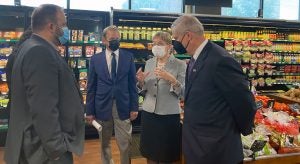[ad_1]
New Year’s Eve 2020 was a major vacation. At least, it felt that way. Soon after a calendar year that we scarcely survived, there was so substantially hope and optimism that we could commence in excess of in 2021. However, world situations never vanish when you improve the calendar. And we’re still reeling from so numerous issues that interrupted our “normal” lives.
The previous two-and-a-50 percent several years have taught us a large amount and uncovered some worrisome troubles. We realized that we weren’t geared up to tackle a public-well being disaster when we ran out of vital professional medical materials in the course of a crucial second. We experienced the significance of mental overall health and how social isolation can deteriorate it. And we discovered that when the apocalypse looms, everyone needs to grab as considerably toilet paper as possible. (I’m mostly being facetious. But as an practically-target of the Great Bathroom Paper Shortage of 2020, my provides are now properly stocked.)
But possibly the most enduring lesson we uncovered is that our source chains are extremely vulnerable. For most of us, the generation, transportation, and sale of shopper products occurs devoid of us noticing. We only go to the store and order the objects we require. We by no means halt to ponder how individuals products and solutions bought on the shelves. As the latest newborn-formula lack reminds us, there’s a ton we choose for granted.

But times like this are an prospect for reflection. The weaknesses in our modern-day life are uncovered, and we can tackle them before the next large thing takes place.
So when the U.S. Section of Agriculture introduced a huge spending challenge aimed at shoring up supply chain troubles and building a additional resilient foods process, it sounded absolutely rational. Most of the spending appears aimed toward achieving these goals: $375 million for expanding impartial meat processors $400 million to produce regional food stuff business enterprise facilities and $600 million in fiscal help to help the food-source-chain infrastructure.
Wonderful. That all seems excellent.
But that was not all. The USDA also ideas on investing $300 million to support farmers transition to natural production.
What??
USDA Secretary Tom Vilsack defended this funding for organic and natural farmers by suggesting it would in some way make farmers more rewarding. In theory, organic items promote for a higher value. Vilsack believes that signifies farmers will see a more substantial part of the sale value.

Which is a mighty large assumption that, to my knowledge, is not supported by any study or other evidence. Even if organic and natural products and solutions fetch a bigger retail price, organic yields are significantly reduce than conventionally developed foods. If you have considerably less to provide, the rate has to be increased to make the very same money. And if the USDA properly adds hundreds of tens of millions of bucks in guidance, all all those new natural farms will flood the marketplace and generate price ranges down in any case.
And whilst we’re on the topic of reduce yields, I can’t fathom why the USDA would winner the natural and organic method to shore up supply chains. Through the following world disaster, I want American farmers to mature a lot more foodstuff, not considerably less. The Nationwide Natural and organic Method is about a label and advertising, not an evaluation of safety, good quality, or greatest techniques. You really do not develop a resilient food items procedure based mostly on a sticker.
Alternatively we require a foods program that is plentiful, adaptive, responsive, and progressive. Not 1 trapped in a marketing and advertising plan that arbitrarily decides what is “synthetic” and what’s “natural.” We can reach that by opening up new marketplaces, minimizing the value of fashionable equipment and technologies, stabilizing our supplies of pesticides and fertilizers, and investing in new investigate.
Funding transitioning farmers does not invest in the suitable matters. In truth, it is so wildly random that it seems far more like a spend off to distinctive pursuits than a answer to our problems.
With record inflation and rapidly climbing gasoline charges, we’re potentially sitting down on the brink of the next financial crisis. Farmers need to have the USDA to handle all those economic hurdles now. Secretary Vilsack superior commence having to pay notice right before it’s too late.
Amanda Zaluckyj weblogs underneath the name The Farmer’s Daughter United states. Her goal is to market farmers and deal with the misinformation swirling around the U.S. food stuff marketplace.
[ad_2]
Supply connection

